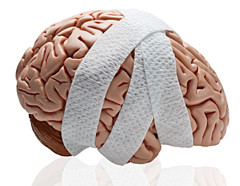New concussion guidelines say “When in doubt, sit it out”

New guidelines for recognizing and managing sports-related concussions could help protect the brains of millions of athletes at all levels of play, from professional football to youth soccer.
The guidelines, released today by the American Academy of Neurology (AAN), replace a now-outdated set published in 1997.
“The new guidelines are a huge step forward,” said Dr. William P. Meehan III, director of the Sports Concussion Clinic at Harvard-affiliated Boston Children’s Hospital, who was not involved creating the new guidelines. “They summarize the best of what we now know about concussion.”
The guidelines step away from trying to “grade” concussions or diagnose them on the field or sidelines. Instead, they focus on immediately removing from play athletes who are suspected of having a concussion until they can be evaluated.
The AAN estimates that concussions cause between 1.6 million and 3.8 million mild brain injuries each year. Concussions happen when something makes the head and brain move quickly back and forth. This can be a jolt to the head, a fall, or a blow to the body. The injury changes how the brain functions. Many athletes don’t get medical attention for these injuries, often because they or their coaches don’t recognize the warning signs or take them seriously.
Here are some of the AAN’s findings and recommendations:
- Concussions are most common in males playing American football or rugby (Dr. Meehan says ice hockey also tops the list) and in females playing soccer or basketball. However, concussions can happen in any sport.
- Concussion is a clinical diagnosis. It isn’t something that can always be identified on the field using one of the numerous symptom checklists or scoring systems that are currently available.
- Athletes who seem to have suffered a concussion should be immediately removed from play and evaluated.
- Athletes who have sustained concussions should not return to play or activity that has a risk of contact activity until a licensed healthcare provider “had judged that the concussion has resolved.” Light exercise may be started beforehand as long as there is no contact risk. The AAN did not set a timeline for safe return to play.
- Athletes who have had one concussion are at greater risk of having another. The first 10 days after a concussion is a period of special danger.
- Athletes with multiple concussions and lingering symptoms should undergo testing. Some should be counseled to retire from play.
Spotting concussions
The new AAN guidelines differ from the old ones in a key way. “These are solid, evidence-based guidelines based on what we know about concussion, while the earlier ones were more a consensus statement of what we believed,” said Dr. Ross Zafonte, a member of the panel that developed the new guidelines and chair of the Department of Physical Medicine and Rehabilitation at Harvard Medical School.
That doesn’t mean the new guidelines are perfect. Rigorous research in concussion was scarce until a decade or so ago, and researchers still have a lot to learn about how concussions damage the brain, how best to prevent them, and how to treat them. But the AAN’s new effort is a good start.
Needed even more are clear guidelines for coaches and athletic trainers, the people who have ring-side seats to watching concussions happen and trying to deal with their aftermath. To make the guidelines truly useful, the next step for the AAN should be to translate the guidelines for coaches and trainers.
In the meantime, for any player with a suspected concussion or showing the symptoms below, “If in doubt, sit it out,” said Dr. Jeffrey S. Kutcher, co-leader of the AAN guidelines panel and associate professor of neurology at the University of Michigan Medical School. “If headaches or other symptoms return with the start of exercise, stop the activity and consult a doctor.”
The Centers for Disease Control and Prevention lists four categories of concussion signs and symptoms:
Physical: Headache; fuzzy or blurry vision; nausea or vomiting (early on); dizziness; sensitivity to noise or light; balance problems; feeling tired or lacking energy
Thinking/remembering: Difficulty thinking clearly; feeling slowed down; difficulty concentrating; difficulty remembering new information
Emotions/mood: Irritability; sadness; being more emotional than usual; nervousness or anxiety
Sleep: Sleeping more or less than usual; trouble falling asleep
Some symptoms appear right away, others may not be noticed for days or months after the injury.
About the Author

Patrick J. Skerrett, Former Executive Editor, Harvard Health Publishing
Disclaimer:
As a service to our readers, Harvard Health Publishing provides access to our library of archived content. Please note the date of last review or update on all articles.
No content on this site, regardless of date, should ever be used as a substitute for direct medical advice from your doctor or other qualified clinician.















